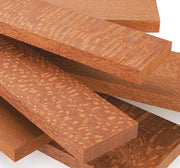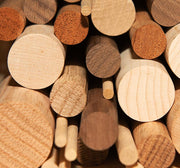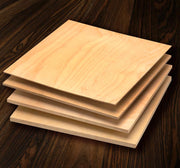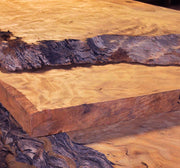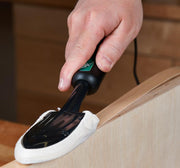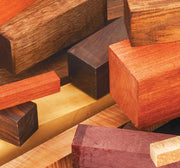CHOOSING THE BEST WOOD FOR WOODWORKING PROJECTS
The first step in starting any woodworking project is determining what kind of wood to use. The types of wood for woodworking are as vast and varied as the projects of woodworkers. Each has unique characteristics, some of which lend themselves to projects better than others.
Wood falls into three categories: hardwood, softwood and exotic hardwoods. The intended use will impact which one is best suited for your project. Other important factors to consider before making your selection include cost, availability and finish.
SOFTWOOD VS. HARDWOOD
Softwood
A wood classified as a softwood doesn't necessarily mean it's weaker than a hardwood. Softwood is so named because they have less dense fibers. They originate from coniferous trees like Cedar, Fir and Pine.
Typically, softwoods are more affordable because they grow faster and tree farms easily source them. Softwoods can be excellent choices of wood for craft projects and wood for small projects.
Hardwood
Hardwoods feature unique textures, colors and grain patterns, which give them a more dazzling and exquisite appearance. Keep in mind that this beauty typically comes at a higher price, especially for exotic woods. Examples of hardwoods include Curly Maple, Birch, Ash, Mahogany, Oak, Poplar, Walnut, Goncalo Alves, Zebrawood and Teak.
Exotic Wood
Exotic wood refers to wood grown outside North America in tropical regions. They have unique grains, striking colors and incredible tonal properties. They tend to be denser and harder than domestic wood species. Some are naturally prone to resist moisture and rot, making them ideal for outdoor projects and high-traffic areas.
INTENDED USE
Your project will determine the type of wood best suited for your needs. Building furniture and toys, turning, carving, pyrography, luthiery and more—each project requires woods with different attributes.
Woods like Oak, Maple, Katalox, and Cherry lend themselves better to furniture and cabinetry.
Canarywood, Bolivian Rosewood, Spalted Tamarind, Walnut and Zebrawood are great to use for turning.
Macassar Ebony, Figured Maple and Ash are great for luthier projects.
Carvers gravitate to woods that are easy to cut like Jelutong, Balsa, Basswood, Mulberry and Tupelo.
The favored woods for wood-burning projects include Basswood, Poplar and Cherry.
CHARACTERISTICS OF WOOD
Wood is renowned for its diverse and appealing characteristics, making it a preferred material for various applications. Its appearance is one of its most celebrated features. The natural grain patterns and colors of wood create a unique aesthetic appeal. Finishing techniques further enhance its visual charm, allowing for a wide range of styles and finishes.
Woodworkers love wood for its strength and impressive durability. It performs well under both tension and compression, making it a reliable material for structural purposes. It also can withstand impacts and stresses.
Wood's versatility, including how easy it is to shape, fasten and finish, makes it highly adaptable for various uses. Its ability to be bent or twisted into intricate designs offers immense creative flexibility in woodworking and furniture design.
Wood has excellent insulating properties. This quality makes it effective in maintaining temperature and reducing energy costs in buildings.
In the realm of acoustics, wood plays a crucial role. The type of wood you pick will determine the kind of finish you can use because different woods absorb finishes differently.
Color variation in wood can range from subtle to dramatic. Different boards from the same tree or different trees entirely can exhibit unique shades and patterns.
Additionally, some woods naturally change color over time (oxidation), adding to their aesthetic appeal. This natural patina is a result of the wood's exposure to oxygen and the sun's UV light.
Some wood like Cherry and Redheart will get deeper and richer in color with time, whereas Maple will turn a more golden hue.
Wood grain (or texture) refers to the consistency of the wood’s surface.
- Coarse: large pores spaced far apart
- Fine: small, tight pores
- Even: uniform with little contrast
Gain patterns influence both the appearance and strength of the wood. They are diverse and can range from:
- Straight (also called rift sawn)—fibers run parallel to the tree's axis. Boards cut from the middle of the tree outwards often feature this type of grain, which is more durable.
- Irregular—fibers run in irregular directions, including in knots.
- Interlocking—fibers spiral around the tree's axis but reverse direction over time. This type of grain is most noticeable in quarter-sawn wood, where it creates a ribbon stripe effect.
- Wavy—fibers change direction constantly, growing in a wavy pattern up the tree. This type of grain is best seen in flatsawn wood.
- Spiral—fibers twist around the tree's axis.
- Diagonal—results from sawing a straight-grained log at an angle.
- Quarter Sawn— the result of a log cut into quarters and then the quarters are sawn diagonally to intersect the growth rings.
- Flat sawn: (also called plain or tangential sawn) — results from cutting a log in a way that the growth rings are generally less than 45 degrees to the face of the plank.
Medullary rays, often visible in Oak, are parallel structures that resemble “stretch marks.” These rays add to the wood's texture and contribute to its structural integrity.
Lastly, mineral streaks are common in many types of wood. These streaks, which can vary in width and length, add unique visual elements to the wood, enhancing its natural beauty.
Be aware some wood has a greater propensity for cracks, knots and/or warping. For some projects, people consider these flaws, while for others, they add character and make the finished project more desirable.
COST
The cost of wood varies by species and grade. Because softwoods grow more quickly than hardwoods, they are usually more affordable. On the other hand, while hardwoods are more expensive, they can provide superior quality and durability for certain applications.
When considering cost, be sure to factor in the expense of specialized tools, fasteners, and finishes. High-end wood varieties, however, could endure longer and need less upkeep or replacement over time.
When selecting wood, balance these aspects against your spending limit and take the long-term investment into account.
FINISH
Finishing enhances wood's natural beauty and protects it from weather, wear, dirt, and other common hazards. The type of wood you choose will affect the kind of finish you can use, as different woods absorb finishes in various ways. Be sure to choose a finish specifically designed for the type of wood you're using.
In addition to offering a wide selection of wood species, Woodcraft has an array of wood options for your next project. We have dimensioned lumber, dowels, plywood, slabs, wood blanks and project material and veneer and edge banding. Likewise, we have a vast selection of tools, equipment and wood supplies for woodworkers.
QUESTIONS?
Visit the retail location near you, or talk to one of our Product Experts by calling 1-800-535-4486.
